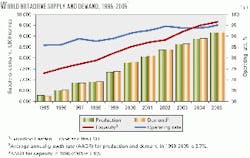Global demand for butadiene will increase at an average 3.7%/year between 1999 and 2005, a rate lower than the compounded rate of 4.0% between 1995 and 1999.
Table 1 lists the world butadiene demand for the period from 1999 to 2005.
Demand for butadiene in the production of ABS (acrylonitrile butadiene styrene) resins and polybutadiene will see the highest average annual rate of growth for all derivatives during the 1999-2005 period.
Polybutadiene will consume more butadiene than all the other derivatives; it will use 600,000 more tonnes of butadiene in 1999-2005 than it did in 1995-1999.
These are the conclusions of an analysis of world butadiene by Chemical Market Associates Inc. (CMAI), Houston.
In 2000, 63% of butadiene demand will have been consumed in the manufacture of synthetic rubbers. Synthetic rubbers include chloroprene rubber, nitrile rubber, polybutadiene rubber, and styrene-butadiene rubber.
Regional demand, capacity
The India subcontinent and Southeast Asia are experiencing the fastest demand growth for butadiene. Although demand declined before 1999, the Former Soviet Union (FSU) will return to positive growth in 2000, said CMAI.
Northeast Asia is the world's largest consuming region for refined butadiene. Its demand will increase by more than 630,000 tonnes during 1999-2005. Demand in Western Europe will increase by more than 450,000 tonnes during this 6-year period, placing it in a distant second position.
The world is adding new butadiene production capacity at 2.3%/year. By 2005, Northeast Asia (China and Taiwan) will add more than 600,000 tonnes of new capacity. Global demand is growing at 3.7%/year, which will outpace capacity additions. Thus, CMAI expects butadiene plants to operate at rates greater than 90.4% of their design capacity by 2005. In 2000, the average operating rate was 85.6%.
Taking into account a loss of 3.0-4.5 percentage points in operating rates as a result of planned and unplanned outages, actual operating rates by 2005 may be closer to 95% of nameplate capacity, said the consulting firm.
According to CMAI, plants in the FSU and Eastern Europe overstate the world's capacity to produce butadiene because they will not run much more than 50% of nameplate capacity in 1999-2005. The FSU and Eastern Europe contain 12.5% of the world's butadiene extraction capacity. Fig. 1 shows aggregate demand, capacity, and operating rates for worldwide butadiene operations, excluding the FSU and Eastern Europe.
Excluding these two regions, worldwide butadiene plant operations will average 95% of nameplate capacity by 2002 and remain high through 2005. In 2000, plant operations, excluding the FSU and Eastern Europe, operated at 91.4% of nameplate capacity. Net world trade for butadiene will increase to about 550,000 tonnes in 2001-02, but new production capacity in North America in 2003 will restrain net trade to 400,000 tonnes.




